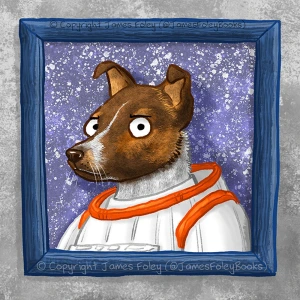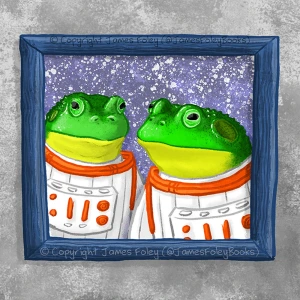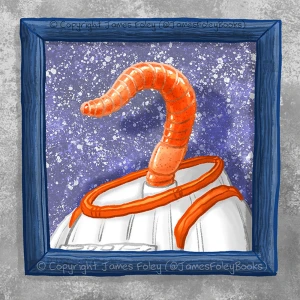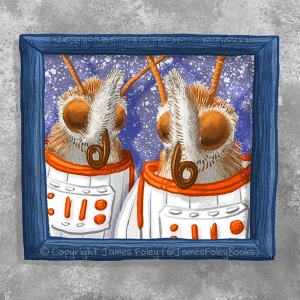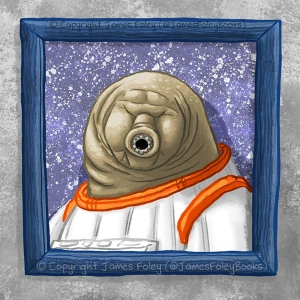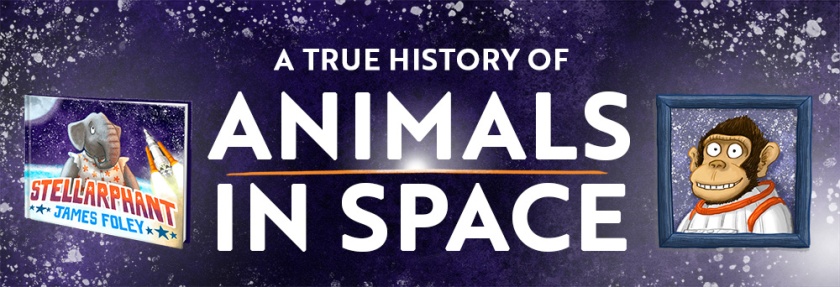
The illustrations on this page originally appeared in the multi-award winning and best-selling picture book Stellarphant, written and illustrated by Western Australian children’s author and illustrator, James Foley.
Scroll down to learn more about each animal and their incredible journeys into space.


Buy Stellarphant here

Animal Astronauts
Click an animal below to learn more about their incredible journey into space.
1947: FRUIT FLY

Date: Feb 20, 1947
Mission: V-2 Rocket No.20
The very first earthlings to travel into space!
The United States launched fruit flies in a V2 rocket to an altitude of 109km (68mi), testing them for radiation exposure.
The fruit flies were recovered alive.
TRIVIA:
Many years later, fruit fly eggs were also among the first bits of Earthling life to land on the far side of the moon! They were in a small biosphere experiment in the Chang’e 4 Chinese probe which landed on January 3rd, 2019. So far, not even humans have been to the far side of the moon; all our moon missions landed on the near side.
1949: ‘ALBERT II’, RHESUS MACAQUE

Date: June 14, 1949
Mission: Albert II
(aka V-2 Rocket No.47,
aka Blossom No.4B)
The first monkey (and the first primate) in space. Albert II reached 134km (83mi) in a US-modified V-2 rocket.
While Albert II did reach space, he sadly did not survive the journey back to Earth.
TRIVIA:
‘Project Albert‘ was a series of rocket test flights in the late 1940s. The first five tests used German V-2 rockets which had been captured by US forces at the end of World War II. Most of the Project Albert flights included a small monkey as a simulated pilot. The first flight was called Albert I, so the monkey involved was also named Albert. The second flight was called Albert II, and so the monkey involved was named Albert II … and so on. The first four tests included monkeys (Alberts I, II, III and IV), while the fifth flight included a mouse who for some reason was not called Albert V. Actually, the mouse is up next …
1950: MOUSE

Date: August 31, 1950
Mission: Albert V
(V-2 Rocket No.51)
The first mouse in space. Name unknown. It reached an altitude of 137km (85mi) in a US-modified V-2 rocket.
Sadly, the mouse did not survive the flight.
TRIVIA:
as mentioned earlier, while this mission was called the Albert V flight, the mouse was not called Albert V.
Just to complicate things, there was a monkey called Albert V who flew on a test flight a year later (April 18, 1951), but that flight wasn’t named Albert V – it was called ‘Aerobee rocket test No USAF-12’. Rolls of the tongue, doesn’t it. Imagine if they’d given that name to the monkey as well.
And there was a mission the year after that (May 21 1952, USAF-26) that had two mice on it, one called Mildred and one called Albert. I hope that clears things up??
1951: ‘TSYGAN’ & ‘DEZIK’, DOGS

Date: July 22, 1951
Mission: Flight IIIA-1
The first dogs in space! Tsygan and Dezik reached an altitude of 110km in their USSR-made R-1 rocket; they did not go into orbit. Both dogs survived.
TRIVIA 1:
while the US space program sent monkeys and apes as some of their first astronauts, the USSR chose to send dogs; the Soviet scientists thought that dogs would be “less fidgety in flight” than monkeys or apes.
TRIVIA 2:
like all the dogs selected for the USSR’s early test flights, Tsygan and Dezik were strays. The Soviet scientists believed that stray dogs would be more resilient and better able to handle the stresses of space travel than dogs that were used to living with the creature comforts of a home.
TRIVIA 3:
the Soviet space program only used female dogs as the device they’d designed to uhh, collect the ‘number 1s and 2s’, was easier to fit on a female dog than a male dog.
1957 – ‘LAIKA’, DOG

Date: November 3, 1957
Mission: Sputnik 2
Laika wasn’t the first dog in space, but she WAS the first earthling to orbit the Earth.
She travelled in a USSR-made spacecraft called Sputnik 2, which was the second-ever manmade object to orbit the Earth (the first being the unmanned satellite, Sputnik 1 which launched 32 days earlier).
Sadly, Laika did not survive the flight.
FACTS: Laika’s actual original name was ‘Kudryavka‘. ‘Laika’ was one of many nicknames she received in training, which roughly translates as ‘barker’. She was also nicknamed ‘Muttnik’ by the press outside of Russia. After her mission, Laika was seen as a national hero and commemorated in many ways, including on Russian postage stamps.
1958 – ‘GORDO’, SQUIRREL MONKEY
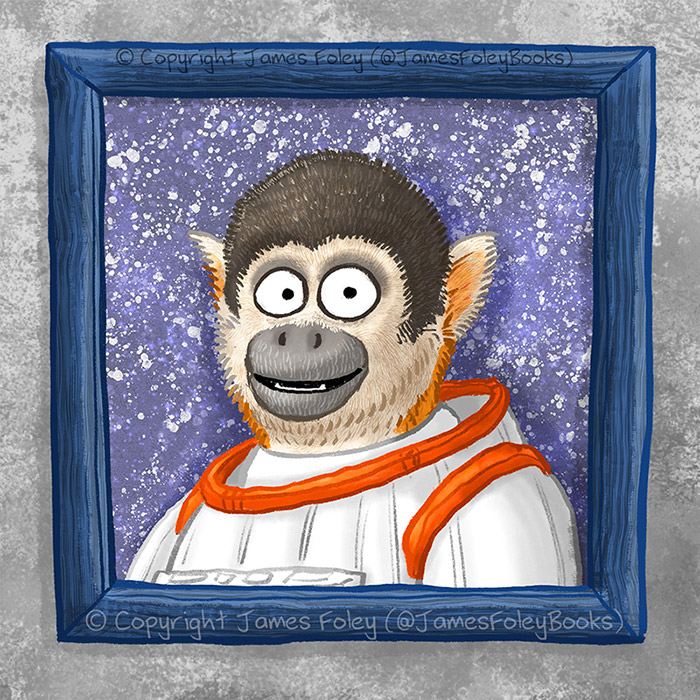
Date: December 13, 1958
Mission: Jupiter AM-13
(aka Bio-Flight No.1)
Gordo, aka ‘Old Reliable’, took off from Cape Canaveral in Florida, USA and reached a height of 467 km (290mi).
The capsule successfully re-entered the Earth’s atmosphere but the parachute malfunctioned; the capsule landed in the South Atlantic, 2400km (1300 nautical miles) from the launch site. Gordo and the capsule were never found.
1959: BACTERIA

Date: May 28, 1959
Mission: Bioflight 2
This US rocket test marks the first spaceflight of bacteria from Earth (or at least the first samples deliberately sent to space, and not just living in the gut of an animal sent previously).
It’s worth noting that these were the first earthling bacteria in space; who knows whether alien species of bacteria might be living elsewhere in our solar system!
The bacteria sample was Escherichia coli (aka E.coli). The rocket also carried sea urchin eggs, fruit fly pupae, fungi and plant samples. The rocket reached 483km height (300mi).
1959: ‘MARFUSHA’, RABBIT

Date: July 2, 1959
Mission: part of a series of R-2A rocket tests
Marfusha travelled into space with two dogs, Otvazhnaya (Brave One) and Snezhinka (Snowflake). All three animals survived the trip.
TRIVIA:
‘Marfusha’ translates as ‘Little Martha’. Marfusha flew on a second mission on June 15th, 1960.
1960: 2 RATS

Date: August 19, 1960
Mission: Sputnik 5
(aka Korabl-Sputnik 2 /
Vostok-1K No. 2)
This Soviet mission carried not just the first rats into space, but also two dogs (Belka and Strelka), over 40 mice, some fruit flies, several plants, human cell samples, and various microorganisms including algae and four species of bacteria.
1961: ‘HAM’, CHIMPANZEE

Date: January 31, 1961
Mission: Mercury-Redstone 2 (MR-2)
Scientists wanted to see if a human-like astronaut would be able to perform simple tasks in space, so they sent a chimpanzee.
Ham was three and a half years old when he flew into space. When he returned to Earth he lived at the US National Zoo in Washington, D.C. and later at the North Carolina Zoo. He died in 1983 aged 25.
TRIVIA:
Ham was either named after the Holloman Aerospace Medical center where he was trained, or after Lieutenant Colonel Hamilton ‘Ham’ Blackshear who commanded the research lab (or both!).
While Ham is the first chimp to travel to space, he did not orbit the Earth. The first (and only) chimp to orbit the Earth was named Enos; he flew on Mercury-Atlas 5 on November 29, 1961.
1961 – GUINEA PIGS, FROGS

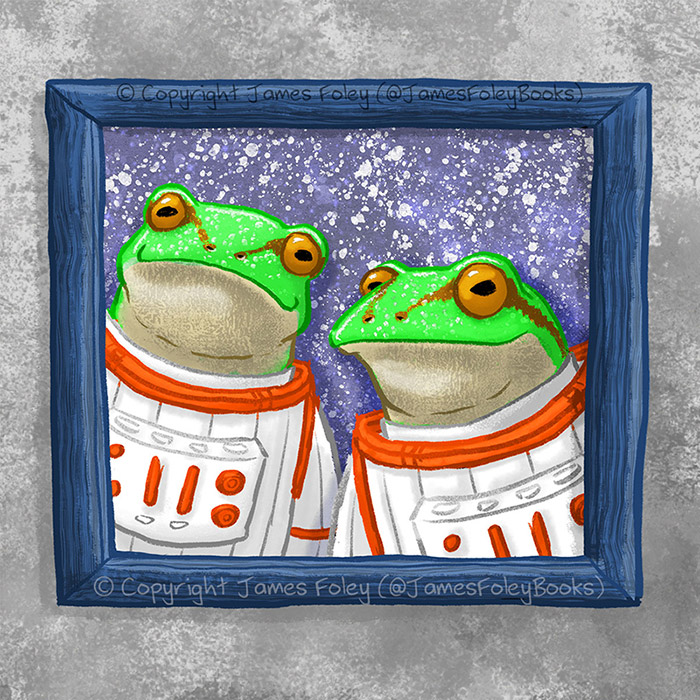
Date: March 9, 1961
Mission: Sputnik 9
(aka Korabl-Sputnik 4,
aka Vostok-3KA No.1)
Both guinea pigs (Cavia porcellus) and frogs (species unknown) travelled to space on this Soviet mission, along with a dog called Chernushka, some mice and some plant seeds. The Soviets also sent a realistic human mannequin (i.e. a dummy) in a spacesuit which they nicknamed Ivan Ivanovitch.
The spacecraft made a single orbit before reentering the Earth’s atmosphere. Ivan the mannequin and all the animals were ejected from the spacecraft to test the emergency eject system; they parachuted to Earth safely.
TRIVIA:
some of the animals were placed in containers inside the body of the mannequin – not only to save space in the capsule, but also so they could stand in for the living tissue of a human cosmonaut. If something horrible happened to the animals due to their time in space, the scientists would know that the spacecraft wasn’t safe for a human either.
BONUS TRIVIA:
the Soviet scientists tested the capsule’s emergency ejector seat by flinging Ivan out of the spacecraft on descent. Ivan’s parachute opened automatically and he landed safely on the snowy ground. However, the villagers who discovered him thought he was a Western pilot ejected from a downed spy plane, and tried to attack him. When the official search party arrived, they rescued Ivan, much to the confusion of the villagers.
1961: YURI GAGARIN

Date: April 12, 1961
Mission: Vostok 1
(aka Vostok 3KA-3)
Gagarin, a pilot from the USSR, was 27 years old when he became the first human to travel to space (as well as the first human to orbit the Earth).
He died 7 years later on March 27, 1968, on a routine training flight.
TRIVIA:
Alan Shepard became the second human (and first US citizen) to travel into space; his mission flew just three weeks after Gagarin (May 5, 1961; Mercury-Redstone 3 / Freedom 7).
BONUS TRIVIA:
Gagarin was not an astronaut, he was a ‘cosmonaut‘ – that’s the English translation of the name the USSR/Russian space programs give their human spacefarers.
The US and European space agencies call their spacefarers ‘astronauts’.
Chinese spacefarers are referred to in English as ‘taikonauts‘ (from the Mandarin word for space, ‘tàikōng‘, + naut).
1963: VALENTINA TERESHKOVA

Date: June 16, 1963
Mission: Vostok 3
(aka Vostok-3KA-8)
Tereshkova, born in the USSR, was the first woman in space. She remains the only woman to have been on a solo space mission.
She orbited the Earth 48 times on a three-day mission, whereas Yuri Gagarin (the first man in space) orbited the earth only once and his mission lasted just under two hours.
Tereshkova later went on to become a politician. At the time of writing this in 2022, she is still alive.
1963: ‘FELICETTE’, CAT
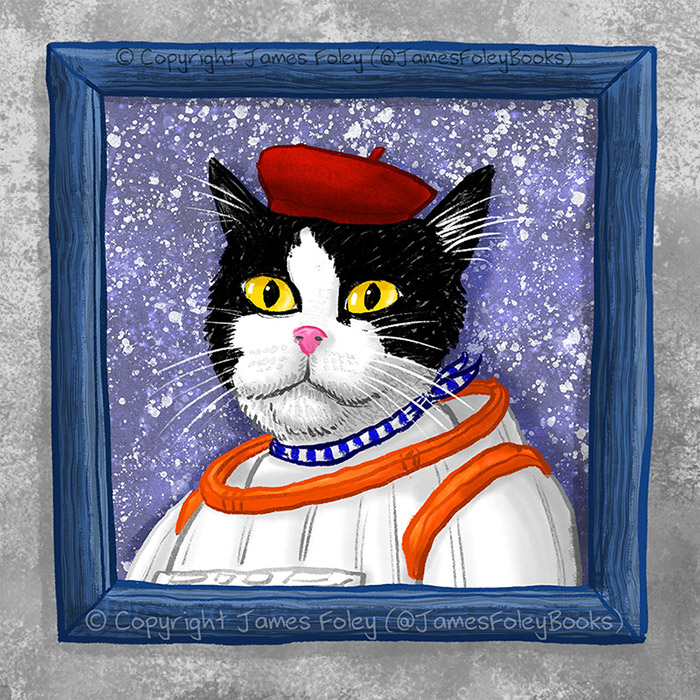
Date: October 18, 1963
Mission: Veronique AGI sounding rocket No.47 (aka Veronique AGI47)
Félicette, a Parisian street cat, is the first and only cat to travel to space.
She was one of 14 cats trained by the French space program.
Félicette’s flight lasted 13 minutes and she returned to Earth safely.
TRIVIA:
She was named after Felix the Cat.
1966: PARASITIC WASPS, AMOEBAE


Date: December 14, 1966
Mission: Biosatellite 1
The US space program sent three unmanned missions into space between 1966 and 1969, called Biosatellite 1, 2 and 3.
Habrobracon hebetor (aka Habrobracon juglandis) is a species of wasp that lays its eggs inside moth caterpillars. US scientists sent some of these wasps to space aboard the Biosatellite 1 so they could study their exposure to gamma radiation. Sadly, none of the wasps developed giant, green alter-egos with super strength.
Biosat 1 also studied the effects of weightlessness on giant amoeba (Chaos carolinensis, sometimes called Pelomyxa carolinensis).
Giant amobae are a single-celled organism that can grow up to 5mm long. They eat bacteria, algae and even tiny insects.
TRIVIA:
both of these species also travelled on Biosatellite 2 in September 1967.
1968 – HORSFIELD TORTOISES, MEALWORMS


Date: September 14, 1968
Mission: Zond 5
The first tortoises and first mealworms in space were also the first earthlings to travel around the moon.
The USSR launched the Zond 5 capsule as preparation for their plan of sending cosmonauts to the moon. The capsule contained 2 Horsfield tortoises (Testudo horsfieldii, also known as Russian or steppe tortoises) and some mealworms (Tenebrio molitor), as well as wine flies, plants, seeds, algae and bacteria.
The mission lasted a week and all animals were recovered safely.
TRIVIA:
the Soviet space program knew that US intelligence would be listening to their broadcasts as Zond 5 approached the moon, so they decided to play a prank. The Soviets pretended some cosmonauts were on the spacecraft and preparing to land on the moon. A cosmonaut called Pavel Popovich had his voice relayed from a Soviet command centre to Zond 5, then sent back to Earth via the spacecraft’s transmitter; US intelligence picked up the broadcast and everyone freaked out – including then-President Nixon!
BONUS TRIVIA:
a year later, the Soviets sent another spacecraft around the Moon, this time called Zond 7. It carried more tortoises as well as a human-sized dummy with the absolutely brilliant name of ‘FM-2 Tissue-Equivalent Phantom Mannequin’. It was made of wheat and sawdust, contained radiation detectors, and the face was modeled after Yuri Gagarin. The FM-2 flew on three missions: twice around the moon (Zond 7, Zond 8) and once around the Earth (Cosmos-368).
1970: BULLFROGS

Date: November 9, 1970
Mission: Orbiting Frog Otolith (OFO 1)
This NASA mission sent two American bullfrogs (Rana catesbeiana) on a one-week trip orbiting the Earth.
Scientists studied the bullfrogs’ ‘otoliths’: special organs in the inner ear of all vertebrates which sense gravity and help with balance and movement. Bullfrogs were chosen because their inner ears closely resemble that of humans.
Scientists wanted to see what happened to the bullfrogs’ otoliths when they experienced a long period of weightlessness. Their bodies adapted well.
This spacecraft was very small – just two bullfrogs in a little satellite, flying around the Earth all on their own!
1972: NEMATODES

Date: April 16, 1972
Mission: Apollo 16
Nematodes, also known as roundworms (Heligmosomoides polygyrus, then referred to as Nematospiroides dubius) first went into space on Apollo 16.
The mission included several other biological samples: bacteria, fungi, viruses, protozoa, mice, red flour beetle eggs and stick insect eggs – even sea monkeys.
This cornucopia of creatures was separated into two experimental units: the ‘Biostack’ (which flew again on Apollo 17 in December 1972) and the much-less-fun-to-say ‘Microbial Response to Space Environment Experiment (M191) System‘.
1973: MUMMICHOG FISH, GARDEN SPIDERS


Date: July 28, 1973
Mission: Skylab 3
The mummichog fish (Fundulus heteroclitus, aka Atlantic killifish) is a minnow found in salt marshes and estuaries on the Atlantic coast of the USA and Canada. It was also the first species of fish to travel to space.
Two juvenile mummichog fish and 50 fish eggs spent 59 days aboard NASA’s Skylab. For the first few days, the juvenile fish spent their time swimming in loops. They had never experienced weightlessness before (of course), and they didn’t know which way was ‘up’. Then they began to rely on the interior lights of Skylab to orient them – just as they would be able to use sunlight on Earth in the same way – and their swimming patterns returned to normal.
The mummichog eggs hatched in the third week aboard the lab, and the baby fish immediately swam normally; they had learned that the lights meant ‘up’ while they were still growing in their eggs.
The Skylab 3 mission also carried two European garden spiders (Araneus diadematus, aka cross spiders or orb weavers) into space. The spiders were named Anita and Arabella. Scientists wanted to study their ability to weave webs in microgravity.
At first, the spiders didn’t want to come out of their small enclosures and into a larger one; they seemed freaked out by weightlessness. But after a while they tried making webs in a larger enclosure. Their first attempts were very small and after a few days they were building webs similar to what they would have made on Earth.
TRIVIA:
Skylab was the first US space station. It had three crews of three astronauts each and was used for about 24 weeks in 1973-4. It burned up in the Earth’s atmosphere and pieces crash-landed in remote Western Australia in the early hours of July 12, 1979.
1982: HONEYBEES, VELVETBEAN CATERPILLAR MOTHS

Date: 22 March, 1982
Mission: STS-3 (Space Shuttle Columbia)
The third space shuttle mission carried an experiment to investigate insect flight in microgravity. It included 24 adult moths & 24 moth pupae (Anticorsia gemnatalis), 14 adult honeybees (Apis mellifera) and twelve common housefly puparia (Musca domestica). Almost all of the pupae and puparia hatched in space.
The bees found it very hard to fly in microgravity; they also found it hard to hold on to the plastic surfaces of their enclosure. The adult moths were still able to fly in microgravity and somewhat able to control their orientation.
The moths that hatched in space tended to do more floating and less flying, as if they had gotten used to the microgravity before they hatched.
The flies spent most of their time walking on the surfaces of their enclosure, and never flew for longer than about four seconds, but were able to control their orientation fairly well in flight.
TRIVIA:
this experiment was organised by an 18-year old US high school student called Todd Nelson. The experiment was selected from 10 finalists in the first-ever Shuttle Student Involvement Project.
BONUS TRIVIA:
honeybees also traveled on the space shuttle Discovery in 1984. Around 3400 worker bees (plus one queen) were included on mission STS-41C. Scientists wanted to study whether the bees could produce honeycomb in microgravity. It turned out they could – but maybe that’s because they were born on Earth and already had some experience in growing honeycomb in normal gravity conditions. It would have been interesting to see if bees that were born in space could still produce honeycomb. The bees also adapted to flying and moving around much better on this mission than on STS-3.
1985 – IBERIAN RIBBED NEWTS

Date: July 10, 1985
Mission: Bion 7
(aka Kosmos/Cosmos 1667 )
Bion 7 was a week-long satellite mission with no human crew; it contained several animals including 10 Iberian ribbed newts (Pleurodeles waltl), the first newts in space. This amazing species has been on many spaceflights since.
The purpose of the mission was medical research; newts are able to regrow their limbs, and scientists wanted to study whether microgravity would affect this ability – they found that regeneration occurred at a higher rate in newts that had spent time in microgravity.
The Bion 7 mission also included 2 rhesus macaques, 10 male rats, 1500 fruit flies, some plants and some guppies.
TRIVIA:
Iberian ribbed newts are famous for their sharp ribs that can puncture their skin to deter predators.
1987: SILKWORMS

Date: August 5, 1987
Mission: FSW-0-9
Silkworms are a type of caterpillar – they’re the larvae of the silk moth (Bombyx mori).
A scientist called Yang Tiande devised an experiment in which silkworms spent 5 days orbiting Earth in a Chinese satellite. The results showed differences in silkworm development while in microgravity: their life cycle was 2-3 days shorter; 50% less eggs hatched; the worms grew to be slightly shorter; and the silk they produced was longer and more reliable.
TRIVIA:
silkworms also traveled to space on the Bion 10 (aka Kosmos 2229) satellite on December 29, 1992; they flew on several space shuttle flights; they’ve even lived on the Tiangong-2 Chinese space station and the International Space Station.
1989: FERTILISED CHICKEN EGGS

Date: 13 March, 1989
Mission: STS-29
(Space Shuttle Discovery)
This experiment – called ‘Chix in Space’ and sponsored by KFC (really) – saw 32 fertilised chicken eggs travel into orbit in a specialized incubator. They spent 5 days in space.
Upon returning to Earth, 8 of the eggs hatched. The first was named Kentucky, and he lived out his days as a celebrity at the Louisville Zoo in the state of Kentucky, USA.
The experiment was originally flown on STS-51-L (the final tragic mission of the Space Shuttle Challenger, January 28, 1986) but was lost in the explosion shortly after launch.
TRIVIA:
this experiment was designed by an American 8th grade student called John Vellinger (although he was a 23yo engineering student by the time the experiment made it to space). John later started a company that makes scientific equipment for NASA to take into space.
1989: EARTHWORMS, RED WOOD ANTS


Date: September 15, 1989
Mission: Bion 9 (Kosmos 2044)
This international mission included the first spaceflight for common earthworms (Lumbricus terrestris) and red wood ants (Formica rufa, aka southern wood ant).
Sadly, both groups of animals died due to equipment failure.
The mission also included 2 Rhesus macaques, 10 rats, desert darkling beetles (Trigonoscelis gigas), flatworms (Dugesia tigrina), fruit flies, Poecilia fish (probably Poecilia reticulata, aka guppies), Iberian-ribbed newts, stick insect eggs (Carausius morosus), E.coli bacteria, algae and plant samples.
TRIVIA:
Guppies flew on this mission and the earlier Bion 8 mission – but they first flew into space even earlier: they were on the Soyuz 21 mission (July 6, 1976) along with some zebrafish eggs.
1990 – JAPANESE QUAIL EGGS
(six hatched in space!)

Date: March 22, 1990
(date of birth of first hatchling)
Mission: Mir EO-6
(Mir space station)
Forty three Japanese quail eggs (Coturnix japonica) were sent to space and six hatched successfully; these were the first birds in space. The little chicks had trouble controlling their movement and gripping onto surfaces in the weightless environment, which made feeding difficult.
A later Mir mission on August 1, 1990 sent 4 adult quails to the Mir station. Each quail was fitted with a special harness so it could stand in place while feeding.
TRIVIA:
Japanese quail eggs were taken on an earlier Soviet mission (Soyuz 32, February 25, 1979) but the chicks had malformations and did not survive. Quail eggs were also taken aboard Bion 5/Kosmos 1129 (25 September 1979), but none hatched.
1991 – JUVENILE JELLYFISH
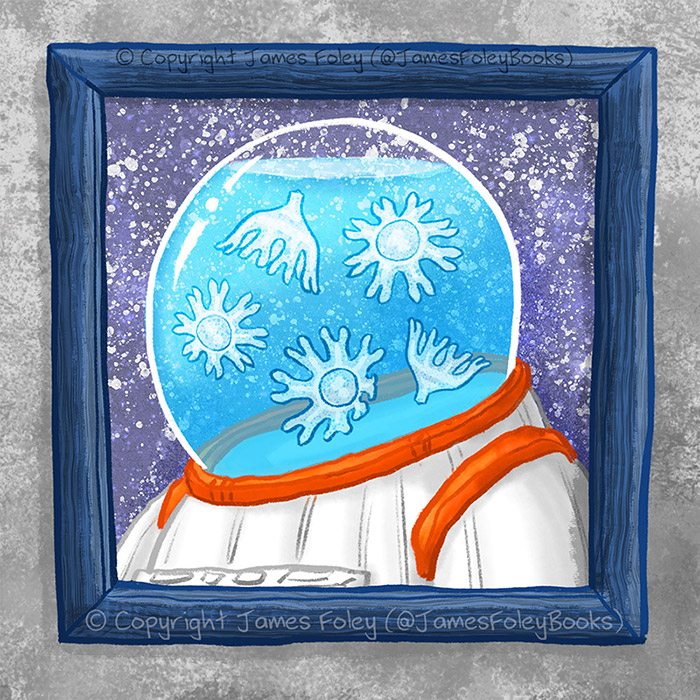
Date: June 6th, 1991
Mission: STS-40
(Space Shuttle Columbia; Spacelab)
Spacelab SLS-1 included a study of the common jellyfish (Aurelia aurita, aka the moon jellyfish).
Jellyfish go through several distinct phases in their life cycle; scientists sent 2,478 jellyfish ‘polyps’ with Spacelab, which over the course of the nine-day mission developed into 60,000 baby jellyfish called ‘ephyrae’ (illustrated here).
The baby jellyfish looked normal, but those raised in space had issues with their swimming (‘pulsing’) behavior; this indicated problems with the development of their gravity receptors (‘statoliths’) and/or their muscle control.
Humans have gravity receptors too (called ‘otoliths’) so these results have some implications for humans – especially if we have babies in space one day.
TRIVIA:
jellyfish polyps and ephyrae are very small (a common jellyfish ephyra grows up to 1cm in diameter) which meant they were easy to transport.
1992: KOI FISH

Date: September 12, 1992
Mission: STS-47
(Space Shuttle Endeavour)
This mission carried Spacelab-J, a joint project of NASA and the National Space Development Agency of Japan (NASDA).
Spacelab-J included a study investigating a possible cause of space motion sickness, using two Japanese Koi (called Cyprinus carpio in the research, but more commonly now called Cyprinus rubrofuscus; C.carpio is better known as the common/Eurasian/European carp). You can see a photo of one of the actual koi in this study.
This mission also included a study of oriental hornets (230 adults, 120 pupae; the study was called the Israel Space Agency Investigation About Hornets, or ISAIAH).
The mission also featured four South African clawed frogs (Xenopus laevis); their eggs were removed and fertilised during the mission, and a few days later they hatched – the first live tadpoles born in space! It wasn’t the first flight for this species though; their first spaceflight was on October 30, 1985 (STS-61A, Space Shuttle Challenger).
1994: GOLDFISH

Date: July 8, 1994
Mission: STS-65
(Space Shuttle Columbia)
The Second International Microgravity Laboratory mission (IML-2) was a set of experiments completed inside Spacelab.
Goldfish (Carassius auratus) went to space for the first time on IML-2; they were part of a Japanese study into the possible cause of space motion sickness.
IML-2 also marked the first spaceflight of Japanese fire-bellied newts (Cynops pyrrhogaster, both adults and eggs); as well as Medaka fish (Oryzias latipes, aka Japanese rice fish aka Japanese killifish).
Some of the newt eggs hatched in space. The medaka were not only the first fish to breed in space, but the first known case of vertebrates breeding (i.e. mating as well as producing offspring) in space.
However it may not the first case of mating happening in space; it’s possible that brown rats mated (although unsuccessfully) on the Cosmos 1129 mission in 1979.
1963: FRESHWATER SNAILS

Date: January 23, 1998
Mission: STS-89
(Space Shuttle Endeavour to Mir space station)
Thirty-five freshwater snails (Biomphalaria glabrata aka pond snail) flew into space on STS-89.
Many snails mated and had babies during the mission.
About two hundred juvenile and four pregnant swordtail fish (Xiphophorus helleri) also flew on the mission.
Scientists were studying the snails’ and fishes’ gravity receptors and general development in microgravity.
1998: OYSTER TOADFISH

Date: April 17, 1998
Mission: STS-90
(Space Shuttle Columbia)
Neurolab was a mission dedicated to neuroscience research.
One experiment involved four oyster toadfish (Opsanus tau). Scientists studied how the fishes’ gravity sensors adapted to microgravity and then readapted when they returned to Earth.
Neurolab also included baby crickets (Acheta domesticus) in an experiment called Crickets in Space, or CRISP; as well as more freshwater snails and swordtail fish.
TRIVIA:
male oyster toadfish make a foghorn-like sound to attract a mate.
They are also really, really ugly. Which makes them fun to draw.
1999 – PAINTED LADY BUTTERFLIES, LADYBIRDS


Date: July 23, 1999
Mission STS-93
(Space Shuttle Columbia)
This mission marks the first ever butterflies in space.
Student scientists from Dougherty County, Georgia, USA designed an experiment involving the larvae (i.e. caterpillars) and some cocoons of the painted lady butterfly (Vanessa cardui). The cocoons were formed on Earth before the flight.
The larvae were still able to form new cocoons in microgravity. And the other cocoons – the ones that were already formed on Earth before the flight – still successfully hatched in space and healthy adults emerged.
The ladybirds experiment was also developed by students – from Liceo No.1 Javiera Carrera High School in Santiago, Chile.
Four ladybirds (Coccinellidae) named John, Paul, George and Ringo were sent into space (to be fair, then, we shouldn’t call them ladybirds or ladybugs – they are clearly ladybeatles).
The study also included a heap of small insects called aphids. Ladybirds hunt aphids; they do this by climbing up the stems of plants. Aphids in turn have adapted to leap from stem to stem to evade their predator. But this situation worked differently in microgravity – the ladybirds were still able to climb the stems, but the aphids couldn’t leap as easily.
2005: SCORPION, TURNER’S THICK-TOED GECKO


Date: May 31, 2005
Mission: Foton-M2
This unmanned mission had a menagerie of animals.
The mission included 2 scorpions (Androctonus australis) and five Turner’s thick-toed geckos (Chondrodactylus turneri). Researchers wanted to investigate how the creatures responded to the stresses of spaceflight.
One of the scorpions survived the flight and returned in excellent health; the other sadly died due to a tail injury.
The geckos adapted well to weightlessness, as they were able to remain attached to the walls of their enclosure for most of the time, reducing their stress levels.
Foton-M2 also included 20 garden snails (Helix aspersa) and 15 Turkish snails (Helix lucorum). Researchers studied whether microgravity changed the snails’ gravity-sensing organs (statocysts). Scientists originally planned on sending freshwater Cuban crayfish (Procambarus cubensis) for this experiment, but replaced them with the Turkish snails at the last minute due to “biocompatibility problems” when preparing the payload for the mission.
The mission also included the AQUACELLS experiment. It was a closed aquatic habitat containing 14-day-old babies of the Mozambique tilapia fish (Oreochromis mossambicus) and a whole bunch of the single-celled Euglena gracilis, an algae-like microorganism capable of producing oxygen through photosynthesis. The experiment tested whether it was possible to use Euglena in space to produce oxygen for life support (result: it was! The fish survived by breathing the oxygen produced by the Euglena. Maybe one day we can use Euglena to produce oxygen for human astronauts too).
This wasn’t the first spaceflight for tilapia fish, though – that was on April 26, 1993 (STS-55, Space Shuttle Columbia).
Iberian ribbed newts also flew on this mission; so did bacteria (Streptomyces lividans 66); and so did two species of lichen, which survived exposure to vacuum, extreme temperatures and radiation.
2006: MADAGASCAR HISSING COCKROACH
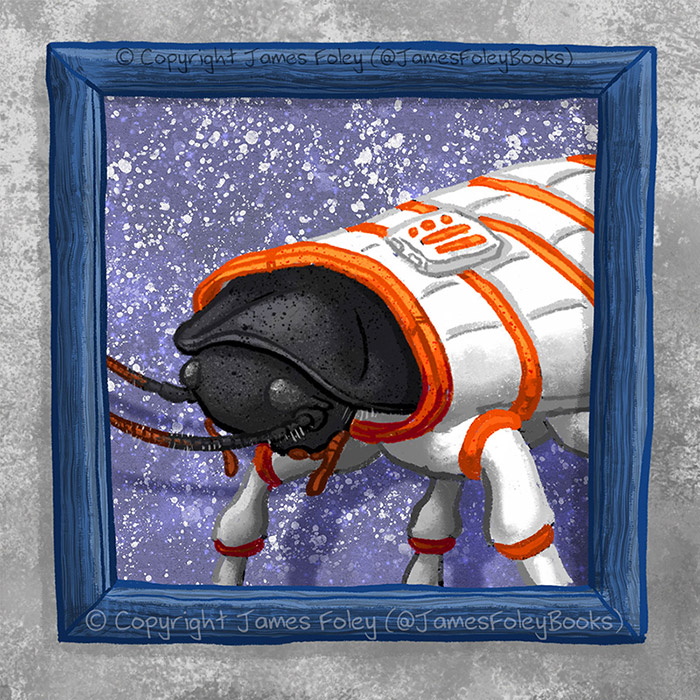
Date: July 12, 2006
Mission: Genesis I
Genesis I is an experimental inflatable space habitat created by Bigelow Aerospace, a private company based in the US.
The satellite launched with four Madagascar hissing cockroaches (Gromphadorhina portentosa) aboard, as well as 20 ‘jumping beans’, i.e. seedpods containing live larva of the jumping bean moth (Cydia saltitans).
TRIVIA:
the company flew a second satellite, Genesis II, on June 28, 2007. Hissing cockroaches also flew on this mission along with a California harvester ant colony (Pogonomyrmex californicus) and South African flat rock scorpions (Hadogenes troglodytes).
2007: TARDIGRADES, MONGOLIAN GERBILS


Date: September 14, 2007
Mission: Foton-M3
Tardigrades, sometimes called water bears or moss piglets, are microscopic creatures with eight legs and segmented bodies.
3000 tardigrades flew on the Foton-M3 mission in a European Space Agency exerpiment called TARDIS: ‘Tardigrades in Space’.
Incredibly, the tardigrades survived exposure to the vacuum of space and cosmic radiation.
12 male Mongolian gerbils (Meriones unguiculatus) also flew on Foton-M3. They were able to adapt to weightlessness within the first day or two of the 12-day mission.
Also on the mission were Iberian ribbed newts, Turner’s thick-toed geckos, garden snails and Turkish snails, as well as bacteria, tilapia fish, silkworm moths, and two female cockroaches.
TRIVIA:
both of the cockroaches apparently conceived while in space. One of the cockroaches, Nadezdha (“Hope”), gave birth to 33 healthy babies once she returned to Earth. Some corners of the internet claim this was the first time babies were conceived in space, but that’s incorrect; Medaka fish bred on the space shuttle Columbia back in 1994.
2009 – MONARCH BUTTERFLIES

Date: November 16, 2009
Mission: STS-129
(Space Shuttle Atlantis; to International Space Station)
This mission included three monarch butterfly larvae (Danaus plexippus) and four painted lady butterfly larvae (Vanessa cardui); it was the first spaceflight for the monarch, while the painted lady first went into space ten years earlier.
Researchers studied the larvae’s ability to go through metamorphosis while in microgravity. The larvae of both species began to form cocoons about 7 days into the mission, then after another 7-10 days they successfully emerged as adult butterflies.
2011 – BOBTAIL SQUID
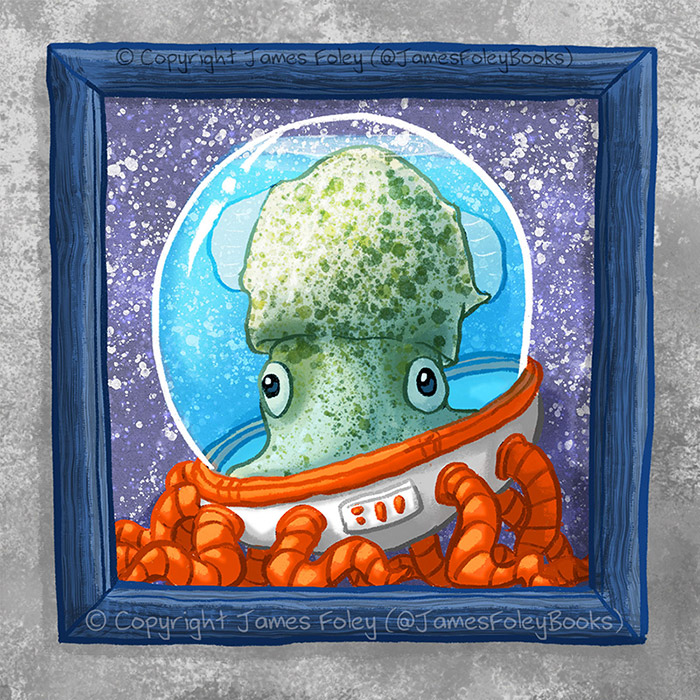
Date: May 16, 2011
Mission: STS-134
(Space shuttle Endeavour; to International Space Station)
Three baby bobtail squid (Euprymna scolopes) – a little smaller and cuter than the one I drew here – were sent aboard STS-134.
Researcher Jamie Foster wanted to study the luminescent Vibrio fischeri bacteria that live symbiotically inside the squid and give it its bioluminescent ability. Baby squid without the bacteria came into contact with it for the first time in microgravity; the bacteria were able to successfully colonise the squids’ bodies, just as they would on Earth. The study has implications for how spaceflight might affect the relationships between human astronauts and the bacteria that live in and on their bodies.
TRIVIA:
baby bobtail squid were also sent to space on the final space shuttle mission (STS-135; July 8, 2011). More recently around 128 baby bobtail squid were sent to the International Space Station (SpaceX CRS-22; June 3, 2021), sharing their flight with 5000 tardigrades.

Buy Stellarphant here






